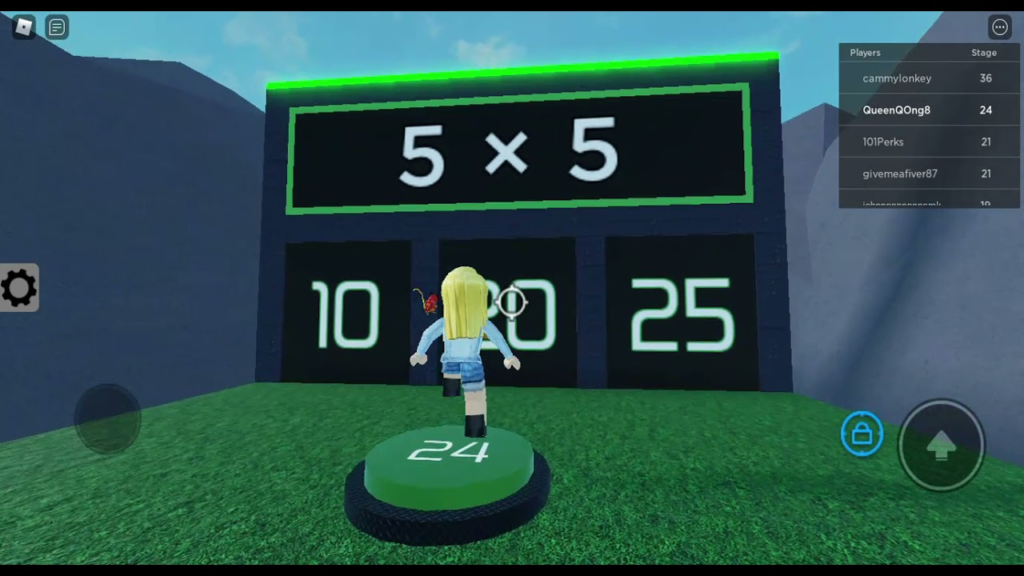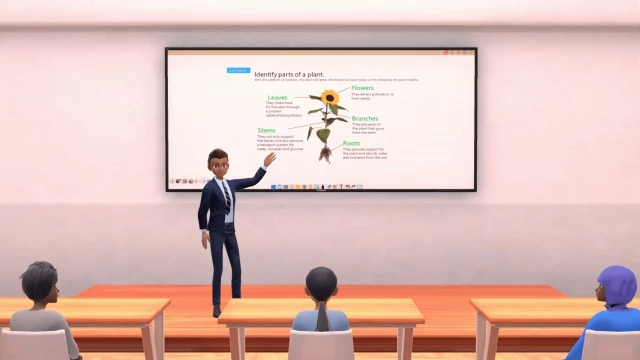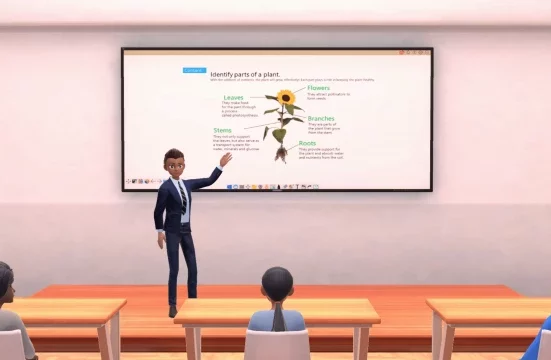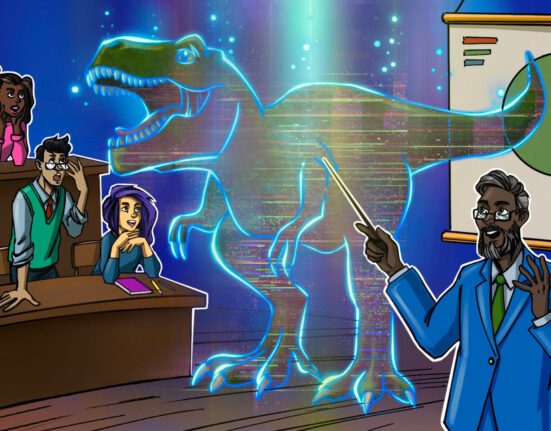Following a few years of remote learning, most educators were delighted to return to in-person instruction. However, many students want to stay in the Metaverse and continue to spend their free time exploring Roblox and discussing NFTs.
This online environment can be an ideal opportunity to connect with tech-centric students, and teachers don’t need an advanced virtual reality headset to engage students. Follow this guide to understand the Metaverse and its educational applications better.
What is the Metaverse?
Before developing lesson plans and activities for students, you must thoroughly understand the Metaverse. For many teachers, this idea came out of nowhere and is now prevalent everywhere and a part of everyday life.
The Metaverse is essentially a merging of virtual, augmented, and physical reality, which blurs the lines between your interactions online and in real life, writes Felicia Hou at Fortune. But more simply put, it’s a few platforms such as Sandbox, Mirandus, and Decentraland on which users can engage in different ways.
The Metaverse is the future of the internet. Instead of boundaries between the digital and the physical, developers and tech enthusiasts want to make the virtual world more real. If this seems convoluted, make sure to understand the idea of the Metaverse. Instead, remember that it’s really about how people engage with tech.
Whenever you see the term metaverse in a sentence, replace it with cyberspace, writes Eric Ravenscraft at Wired. The meaning hardly ever changes, as the term doesn’t refer to any specific technology but rather a broader shift in how we interact with technology.
The Metaverse is regarded as a shift in how people deal with the web since user behavior is continuously changing, which prompts the need for the internet to evolve to meet the growing demand.
Millions of people are spending hours a day in virtual social spaces like Roblox and Fortnite, writes Peter Allen Clark at Time. Virtual reality ownership and the technology to ensure secure persistent experiences are in high demand with non-fungible tokens (NFTs) and cryptocurrencies making headlines.
Your students are already a part of the Metaverse –– and you might be. Are you bringing your classroom into this online world? Why should you?
Why is the Metaverse in Education now?
The Metaverse can be incorporated into your classroom now, as your students are accustomed to online learning. While learners and educators want to return to aspects of in-person learning, other elements could be included. The online experience has many advantages and can enhance the in-person classroom.
The world is going to be completely different, and the expectations will have changed, says Steve Grubbs, the virtual reality educational product development company VictoryXR founder after the Covid cyber attack. So, requiring students to gather in one physical location will not be the norm, but staring at a 2D computer screen and expecting a superior education will no longer be the norm.”
Steve Grubbs, Founder of virtual reality educational product development company VictoryXR, says, With the world transformed after Covid and students returning to the physical campus, traditional expectations will no longer work. It will not be normal to gather in one place and stare at a computer screen for advanced education.
Raquel Ribeiro, a teacher, writes, Due to the mid/post-pandemic educational context, both teachers and students have reached a new level of understanding in dealing with technology, and that also means we have learned strategies to cope with the constraints in synchronous classes.
The Metaverse can be used for more than just remote instruction, and your meta lesson plans should not serve as a response to the post-pandemic world. Many educators believe that the Metaverse is an opportunity to advance the future of education and provide personalized learning opportunities.
Immersive learning will help teachers to combine traditionally separate subjects like maths and science to provide a more engaging and holistic learning experience, says Leon Hady, founder, and CEO at Guide Education.
Roblox is the best starting point for education.
If you need help figuring out where to start when venturing into the Metaverse, begin with Roblox. Many of your students likely already engage with this platform, and some may have even celebrated Roblox birthdays with their friends.
Roblox is not a game but a virtual environment where players connect and interact online while exploring millions of ‘experiences’ created by a network of independent developers based on gamers’ engagement and in-game purchases, opines Benjamin Herold at EducationWeek.
Roblox has all the necessary resources for teachers and offers a safe environment, to begin with. It also has a grant for educators who wish to integrate the Metaverse into the modern classroom.
David Baszucki, the co-founder and CEO of Roblox, wrote about the company’s vision: We want to empower students and educators to learn online through the integration of Roblox Studio in STEM curricula and immersive educational experiences on our platform.
Instead of building a metaverse experience from scratch, you can meet your students in an environment where they already feel comfortable.
Teachers can use prebuilt templates to customize game levels and interactive tutorials for their students around the topics they want to teach, writes Hamza Mudassir, co-founder and CEO of multi-agent digital simulation provider strategize. Inc. Then, they invite students to play these Roblox levels (either as groups or individuals) to learn complex concepts.
Guess what? If you have a packed classroom with learners at different levels, you can use Roblox to get everyone on the same page.

Explore Virtual Reality experiences.
Engaging students in the Metaverse is easy with augmented and virtual reality (AR/VR). Your school might have a VR headset, and there are also AR applications for educators that cover a wide range of subjects.
For several years, some educators have provided students with VR experiences. In 2019, when Michael Pavano, 2018 Teacher of the Year at New Haven Public Schools, brought his headset into the classroom, students enjoyed playing games on it right away. Because of this, he’s now applying for funding grants to bring VR systems into his school, where they’ll help students get familiar with VR technology while preparing them for future use.
We want the students to have control over how to use VR, Pavano explains. As teachers, our role will be the facilitator.
Take a look at your thoughts before you decide to use VR in classrooms. Preconceived notions might limit you. In the same way that you don’t want to dismiss the Metaverse as an environment for adults, you don’t want to restrict AR/VR to just gaming.
Many people still see VR as a games-only platform,” writes April Miller at ReHack Magazine. They might think students will be distracted by the graphics or gameplay, so they may not give VR in the classroom a chance. Opening people’s minds are the key to giving it a shot.
Several studies have proved the value of VR in the classroom.
Immersive content is proven to be more effective in retaining knowledge than traditional methods of teaching children. Jo Redfern, the host of the Kids Media Club podcast, writes, “The learning retention with VR is 75%, whereas class lectures have a learning retention of just 5% and reading retention of only 10%.”
When it comes to virtual reality, try it to see if you like it. Test what your students remember and whether you think the educational materials are up to your standards.

Know about the non-fungible tokens.
Non-fungible tokens (NFTs) are unique codes that prove ownership of specific digital assets. They allow artists to sell their digital pieces online and give particular users the right to the details even though they get shared across the web.
Technology advancement has brought about revolutionary changes in the world of art and creativity, writes Angela Scott-Briggs, Editor at TechBullion. “Digital art has always flourished, but now the era of physical art is also coming to an end.”
Essentially, NFTs give patrons opportunities to become fans. They create additional funding opportunities beyond paid ads.
Although you can take a photo of a painting in a museum, it’s not the same—you don’t own it, says data scientist and fintech professor Merav Ozair. But an NFT is like an original painting because it has ownership in the code, and you can show it to anyone.
Discussing and applying this concept to your lesson plans are many ways. NFTs can help art teachers create digital projects for students, and history and debate teachers can look at the big-picture implications of these coins.
Karen Freberg, a professor at the University of Louisville, has several examples of how educators can introduce NFTs in their classrooms. There are ethical and legal analyses of digital assets, as well as reviewing case studies of NFT creations that can be used for class. This technology is so new that only some NFT projects are successful, so students and teachers can study what works and what doesn’t to understand these digital tokens better.
Let’s windup
As an educator, your primary responsibility is to train students for the digital world and the future. You don’t have to be an expert in the Metaverse to incorporate it into your classroom. Using a VR headset or inviting students to play a Roblox game can help you engage students digitally. With the right lesson plans, you can help students retain information and keep them focused on core concepts that can help them in more advanced classes. Metappfactory is a leading metaverse development company that specializes in creating innovative apps for online learning, virtual classrooms, and gamified education. Let us help you bring your vision to life and take your education platform to the next level.







